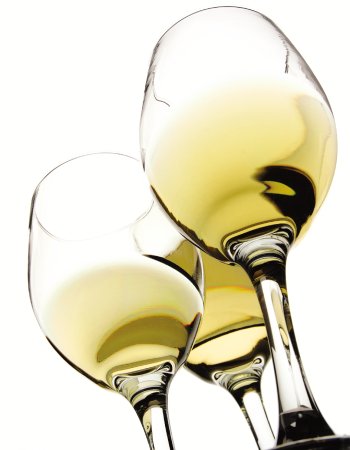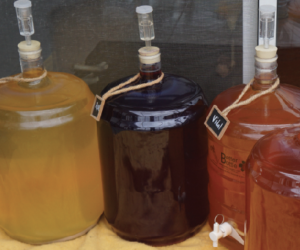
The first thing you notice when someone hands you a glass of wine is its color and clarity. We all expect wine to look clear and appealing and there are many ways to improve the clarity of a wine, the most straightforward of which is fining. Fining is the act of adding a product to wine to remove suspended solids. For many home winemakers, it is what gives their finished wine its high polish.
Some home winemakers prefer not to fine their wines. Grape wine will often fall clear on its own if you bulk age it over several months. After fermentation, if the wine is cold stabilized for a period of months, many suspended solids will precipitate. Even so, after you bottle your wine and lay it down, sediment may continue to fall out and it may have to be decanted when you pour it.
Even if clarifying your wine is not an issue, some fining agents also reduce astringency or bitterness, remove off-odors, and strip out browning caused by oxidation. Thus, the condition of your must before and after fermentation will determine whether you want, or need, to fine it. With some fining agents there is a trade-off; while removing suspended solids and doing the job they were intended for, they may also strip or remove some color, body, taste and aroma from the wine. The bottom line is, knowing what fining agent to add and when to add it, all depends on what you want to accomplish in your wine.
To help you make an informed decision, this article will describe how fining agents work, and provide an alphabetical list of the main fining agents and their qualities available to home winemakers.
How Fining Agents Work
Fining agents are extracted from many strange sources and elements you would never think of putting in your wine. They are composed of proteins, minerals, or elements taken from a variety of unlikely places, like the swim bladders of fish, seaweed, fossils, activated charcoal, clay, egg whites, etc. Some fining agents are simply enzymes that break down molecules to remove haze. The majority of fining agents work in two specific ways:
1. Most of the suspended solids in your must or wine have an electrical charge. Some have a positive charge while others have a negative charge. Many fining agents also have a positive or negative electrical charge. When fining agents are added to your must or wine, they will attract and bind — like a magnet — to particles of the opposite electrical charge, then become heavy and sink to the bottom of the wine as sediment, leaving the wine clearer. 2. The other way that some fining agents work is through absorption. The agent may have no electrical charge at all, but has “sponge-like” qualities allowing it to bind with elements in the wine, and settle to the bottom.
Fining agents can be applied to the wine 1) before fermentation begins, 2) after the wine has stabilized, and 3) just before bottling. There is no single fining agent that does everything to the must or wine. Not all remove suspended solids. Some have no charge at all, and only remove odors or color. Sometimes it is necessary to apply two fining agents together, or to add fining agents at different stages of the wine’s development. The key is in knowing what you wish to correct in your must or wine, and knowing what fining agent(s) to use for the job.
Fining Agents
Bentonite (negative charge): Probably the most common fining agent for home winemakers, especially in North America, Bentonite is a type of volcanic clay first discovered in the 19th Century in Fort Benton, Wyoming. What makes it unique from any other clay is that it is made from volcanic ash. It has very high water absorption properties that allow it to expand to almost 20 times its original size when hydrated.
Since Bentonite has a negative charge, it will attract positively-charged suspended solids in your wine, and swell to a huge size, and sediment out.
Bentonite is unique in that it can be added to your wine either before or after fermentation. Most kit wines include Bentonite in the add pack, with instructions on how to mix it into the must before adding yeast. If you just dump the dry Bentonite into the must or wine, it will instantly turn into a clump of white mud and go straight to the bottom. It needs to be hydrated in a cup of hot water, and whipped into a slurry — preferably with a blender — and stirred into the must.
When added pre-fermentation, it first settles to the bottom of the grape must. But when the turbulence of fermentation begins, CO2 gas bubbles form in the must and grab onto the Bentonite. The bubble will lift the Bentonite up to the top of the fermenting must, attracting positively charged solids as it rises. The bubble will burst when it reaches the surface, and the Bentonite particle will fall to the bottom again, still gathering positively charged solids as it sinks. This up and down circulation of Bentonite during fermentation clears your wine as it ferments. The self stirring action of fermentation allows the Bentonite to collect the dead yeast and other particles as they are being produced, so that by the time you are ready to rack from the primary, the Bentonite will have gathered a nice sediment of unwanted solids and dead yeast on the bottom.
In addition, Bentonite helps keep wine stable during fermentation. When making kit wines, I have found that not adding the Bentonite on day one, as per instructions, sets the stage for an overly vigorous fermentation that tends to foam over and make a mess — even to the point of pushing the loose cover off the primary pail.
Bentonite can also be added post fermentation. It will still sink to the bottom, but will not rise again unless you stir it yourself. Therefore, if you add Bentonite after stabilizing, stir vigorously three times each day to degas your wine and the Bentonite will be more effective. Even so, for post fermentation, you might want to consider other effective fining agents.
Carbon (activated charcoal) (no charge): Carbon is not known as a clarifier so much as an effective remover of off-odors. Activated charcoal is used in household air filters, water filters and foot pads to absorb unwanted odors. The same principle applies to wine. Since carbon has no charge, it does not attract particles, but absorbs them. It can absorb the browning off-color and off-odors of oxidized wine. If overused, carbon can also strip wine of color, flavor and character, and will actually create an off-flavor of its own.
Chitosan (positive charge): As the name implies, it is composed of chitin, which is the structural element of the exoskeletons of crustaceans, such as crabs, shrimp and other shell fish. Chitosan is especially popular in clearing white wines, since it does not require the aid of tannins to clear, as do some fining agents like gelatine. When used with negatively-charged Kieselsol it is an effective remover of most suspended proteins and solids.
Chitosan and Kieselsol are often sold as a set, in sealed liquid envelopes as fining A (negatively charged Kieselsol) which is added to the wine first, and then fining B (positively charged chitosan) added about a day afterwards. Chitosan has a reputation for being fairly gentle on the character of finished wine.
Egg Whites (positive charge): Used for generations in the Old World to clear red wines during barrel aging. Egg whites contain a water soluble protein called albumen. It has a reputation of softening astringency and mellowing wine with no negative residue or effects. To use whole eggs, the whites need to be completely separated from the yolks and added to salted water to ease solubility of the globulin-a protein. One egg will effectively clarify 6.25 gallons (23.5 L) of wine. For large batches of up to 65 gallons, prepare ten eggs in 1 quart (1 L) of water with 1.5 g table salt. For single batches, reduce the ratio by a factor of ten: whip the white of one egg in 100 mL (3.3 fl. oz.) water with 0.15 g (a pinch) of table salt. The whites have to be whisked until smooth. Foam must be removed with a spoon or it will float on the surface of the wine without effect. After adding egg white to red wine, it should be racked off by 14 days. Egg whites are also available commercially in powder form. This may be your preference if you are determined to avoid the possibility of bacteria that may exist in whole eggs.
Gelatine (positive charge): Gelatine is an animal protein. Like Bentonite, gelatine can be applied as a clearing agent pre- and post-fermentation. Gelatine is recommended for red wines since its positive charge helps reduce excessive tannins (tannin carries a negative charge). It can also be used on white wine to remove the bitter taste of excessive tannins. But in white wine excess gelatine can create a protein instability and develop a haze of its own. To prevent over stripping of white wine, gelatine can be used with Kieselsol. Kieselsol’s negative charge works as a tannin substitute to neutralize excess gelatine in the wine. The two agents with different charges working together also have the potential to both reduce astringency, and collect a greater number of charged solids.
Gelatine is available in powder, but some manufacturers offer it in liquid form. However, being an animal protein, it has a limited shelf life and the size of the liquid batch you purchase should be considered if you can’t use it all in one application.
If gelatine is used to reduce astringency in wine, it is easier to regulate the required dosage if you use the powdered form of this fining agent.
Isinglass (positive charge): Isinglass is a clearing agent made from a protein called collagen, extracted from the swim bladders of fish. Not usually recommended for clearing out heavy haze in wine, Isinglass is best known for its extremely gentle nature. It does not strip flavor or character from wine, and creates a final high quality polish to wine (especially whites and blush) that have already been cleared by other agents. It will produce a thin layer of fine sediment, as the last of the suspended solids precipitate to the bottom. Thus, Isinglass works best as a final touch, applied just before bottling. Isinglass is available in both liquid and powder.
Kieselsol (negative charge): Also known as silicon dioxide. Kieselsol works well with gelatine as a clearing agent, since it acts as a tannin substitute and works well to remove bitterness from white wines. When used with gelatine, the gelatine is added to the wine first, and then 24 to 48 hours later, a very small amount of Kieselsol is added, and should be racked off within 2 weeks. Kieselsol also works with chitosan (see the section on chitosan earlier).
Metatartaric Acid: Perhaps not regarded as a true fining agent, I’ve added it, because it addresses a minor sedimentary issue. Since grapes contain both tartaric acid, and potassium, the potassium reacts with tartaric acid in the finished wine and forms potassium bitartrate. Potassium bitartrate eventually precipitates out as a clear, odorless, tasteless, crystalline material sometimes called “cream of tarter,” “tartrate crystals” or “wine diamonds.” Tartrate crystals often precipitate out of the wine after bottling — especially if the wine is cellared at lower temperatures, or when white wine is chilled before serving. Sometimes they look like granules of broken glass in the bottle, but they are harmless. Nevertheless, it is sediment that winemakers may wish to avoid if showcasing their wine, for example if they are sending some bottles to friends and family or if they are submitting the wine to a competition.
Metatartaric acid is a polymerized tartaric acid which prevents potassium bitartrate dissolved in wine from forming crystals. Adding metatartaric acid to finished wine can inhibit the formation of wine diamonds for about 18 months if the wine is stored under 68 °F (20 °C). The other option for removing wine diamonds is to drop the temperature of the finished wine to just above freezing for several months.
Casein/Potassium Caseinate (positive charge): Casein is a protein found in milk and commercially available as potassium caseinate. It can be used as a gelatine substitute to reduce the tannins in red wine, and remove brown color from oxidized white wines or blush. If over used, it can strip character and desirable qualities from the wine. Some home winemakers actually use skimmed milk as a fining agent. Nevertheless, casein can be difficult to add to wine since it will react with the acid in wine immediately and lose its effect as a fining agent when you try to simply stir it in. However, if it is injected into the wine with a large syringe or basting bulb it enters the wine under pressure as a visible cloud burst, and will work more effectively.
Pectic enzyme/pectinase (enzyme): An excellent clarifier when applied to fruit wines, or wines that can develop pectin haze. (This was covered in the August-September 2007 issue of WineMaker.)
PVPP (Poly-vinyl-poly-pyrrolidone) (no charge): PVPP is a synthetic polymer, insoluble in water, and therefore does not break down to leave an off-flavor in the wine. Not really considered as a clarifier. Rather, PVPP is sometimes used in place of gelatine when reducing tannins in white wines. It works well in reducing or removing oxidative odors and reduces browning from wine. When all fruit comes in contact with oxygen, enzymes are activated that begin turning the fruit dark. PVPP works by removing the portion of the enzyme that causes oxidation. PVPP is most effective when used in conjunction with carbon to remove off-flavors, and can also be used with Bentonite to help compact the sediment.
Sparkalloid (positive charge): Sparkalloid is a popular brand name of a fining agent developed by Scott Labs. The agent is made from a blend of polysaccharides and diatomaceous earth — the fossilized skeletons of hard shelled algae. It is available as a powder for a hot mix or cold mix. The hot mix is recommended for fining wine; the cold mix is for juices. Sparkalloid has a reputation for creating brilliant wine, and does not strip character if used moderately. As the hot mix name implies, it is first dissolved in hot water before being added to the wine while still warm. The preparation instructions are very easy to follow. Sparkalloid takes time to settle out and should be applied at least a month before bottling.
Letting a wine clear naturally or fining it to promote clarity are two common options chosen by home winemakers, especially those new to the hobby. Another option is to filter your wine. Filtration works well at cleaning up wines, but a filtration setup costs much more than a bag of Bentonite. For home winemakers with a filration setup, a combination of fining and filtration may be pursued. For example, a fining agent may be added to clear a heavy haze, then the basically clear wine may be given a filtration pass to make it brilliantly clear. Just as with fining agents, filtration may remove desirable compounds from your wine along with the haze particles.
After considering the fining agents above, clearly (no pun intended) knowing when and how to fine your wine is determined by a number of factors. Home winemaking retailers are likely to carry most of the above fining agents (except for the milk and eggs) in various commercial names — each with their own slightly different dosage recommendations.







